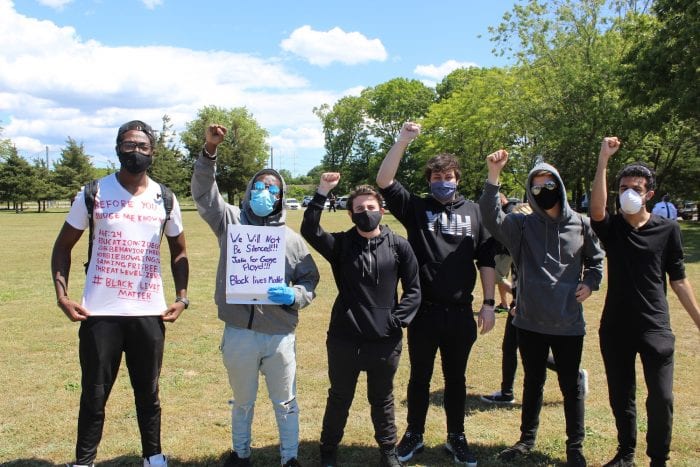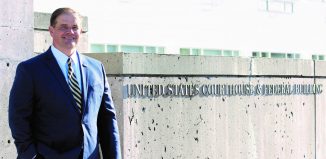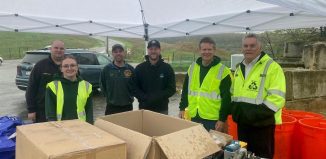Suffolk County’s 311 Line Will Field Calls About Hate Crimes

In response to the ongoing unrest in the country caused by the murder of Minneapolis resident George Floyd by a former police officer who has now been charged with second-degree murder, Suffolk County will field hate or bias crime calls through its 311 number.
Starting today, residents can call 311 to address concerns about bias or hate crimes that they are subjected to or that they witness.
“Hate, bias, bigotry and discrimination have no safe haven in Suffolk County,” County Executive Steve Bellone (D) said on his daily conference call with reporters. Operators will be ready to provide information or transfer callers to the Human Rights Commission, as needed.
At protests around the county, which included seven such gatherings yesterday in Suffolk, residents are expressing concerns about hate crimes and bias, Bellone said.
The county executive continued to show an appreciation for the way demonstrators behaved during their protests and the ongoing protection and surveillance from police.
“The demonstrations we have seen have been peaceful,” Bellone said. “They represent a contrast with events that have transpired in other communities in our country. That is a credit to the people demonstrating and to the Suffolk County Police Department.”
Amid the economic devastation from the lockdown, Bellone commissioned a financial report that he presented to various public sector unions earlier today. The report anticipates a revenue shortfall of between $1.1 billion and $1.3 billion over the next two years.
Bellone shared with those unions his hope that federal representatives, including Sen. Charles Schumer (D) and Lee Zeldin (R-NY-1) will continue to support the county and will endorse financial assistance amid the financial devastation caused by the virus.
Bellone didn’t offer the unions any specific assurances, saying that he wanted to give them the foundation of the financial issues the county was facing.
Meanwhile, outdoor seating at restaurants will be allowed throughout the state as each region reaches phase two of its reopening. At the latest, Suffolk County could enter that phase next Wednesday.
SC Taskforce Worst Case Scenario Projects $590 Mln Revenue Shortfall for 2020
None of the choices is particularly appealing, but V is certainly better than W and U.
A COVID-19 Fiscal Impact Task Force report projected a range of economic scenarios for the county, depending on the impact of the virus later this year. In a “V” case, the economy rebounds quickly and continues to climb.
A “W” scenario, on the other hand, recovers, then stumbles amid a second wave of the virus that doesn’t require a lockdown, and then stages another recovery.
The worst-case scenario, however, is the “U,” in which a second wave presents enough of a recurring public health crisis that the economy recovers far more slowly.
The three possibilities will likely dictate the extent of the revenue shortfall over the next three years.
About $329 million of the overall revenue shortfalls come from actual declines in sales tax collection so far in 2020. Additionally, the task force, which included Emily Youssouf, Larian Angelo, Michael Kelly and Nathan Leventhal, anticipates a 4.9 percent shortfall in property tax collections, which translates into a reduction in collections of $35 million.
The group also projected a $30 million revenue shortfall from OTB/ casino and motel/ hotel taxes.
The range of revenue shortfalls through 2022 are from $1.136 billion to $1.518 billion. The biggest single-year gap between projected revenue and actual revenue would be in the “U” scenario for this year, for which the county would come up $590 million short.
The task force concluded that the current economic outlook requires a swift and dramatic response to prevent an economic disaster.
“Even the most optimistic scenario which the task force has examined will place enormous pressure on the ability of the county to maintain an acceptable level of government service which the County’s residents have every right to expect,” the group warned in its conclusions.
Viral Numbers
The number of residents who tested positive for the virus was 82, raising the total with confirmed cases of COVID-19 to 40,062. With 4,840 tests, that represents a 1.7% percent positive rate among those tested, which is well below the rate for positive tests in April.
The number of people who are hospitalized with COVID-19 declined by 11 to 236 as of the 24 hours ending on June 1. The number of people in Intensive Care Unit beds also fell by six to 61.
The percentage of people in hospital beds with COVID-19 was 63 percent, while the percentage in the ICU was 52 percent, both of which provide the kind of flexibility in the health care system the state hoped to provide.






